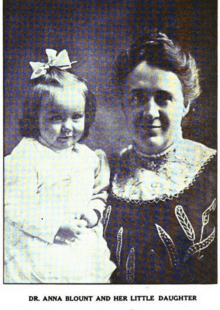Anna Blount

Anna Blount was an American physician from Chicago,[1] and Oak Park.[2] She encouraged other women to become physicians and was the president of the National Medical Women's Association.[3]
She was a proponent of birth control and a leader in the birth control movement in the United States.[4] She was a frequent contributor to the Birth Control Review.[5] She served on the committee of the First American Birth Control Conference.[6] Blount gave lectures on "sex hygiene" to Chicago high schools,[7] clubs and to universities.[8] She created pamphlets, such as A Talk With Mothers, which discussed condom use.[9] She believed that "shielding women" from information about sexually transmitted disease was wrong.[10] When it was still illegal to do so, Blount gave out information about birth control in direct violation of laws against discussing birth control in order to test those laws.[11]
Blount also supported the idea of eugenics.[12] Blount called eugenics "the most important movement of modern times."[13] She chaired the Eugenics Education Society of Chicago.[14] Blount believed that people should choose to have children with only the most mentally and physically healthy individuals.[15] She believed that "cruelty is a hereditary characteristic."[16] She connected alcoholism with heredity as well.[10] Blount even believed that lowering the population size would prevent war and world hunger.[17]
Blount did not believe that people who were unhappy with one another should stay married, and proposed that obtaining a divorce should be made easier in the courts.[18] She advocated that juries on divorce trials should be made up of women.[19]
She was a leader in the women's suffrage movement.[20][21][22][23][24] She was a member of the Chicago Woman's Club.[4] Blount spoke out against club organizations attempting to prevent African American women from joining.[2]
References
Citations
- ↑ "Suffragists Find Teas Help Cause". The Leavenworth Times. 7 January 1913. Retrieved 22 January 2017 – via Newspapers.com.
- 1 2 Knupfer, Anne Meis (1996). Toward a Tenderer Humanity and a Nobler Womanhood: African American Women's Clubs in Turn-of-the-Century Chicago. New York: New York University Press. p. 54. ISBN 0814746713.
- ↑ "U.W. Clubs". The Wisconsin Alumni Magazine. 27 (9): 288. July 1926.
- 1 2 "Protests Move to Curb Birth". Chicago Daily Tribune. 3 January 1917. Retrieved 18 January 2017 – via Newspapers.com.
- ↑ Weingarten, Karen (2014). Abortion in the American Imagination: Before Life and Choice, 1880-1940. New Brunswick, New Jersey: Rutgers University Press. p. 52. ISBN 9780813565309.
- ↑ "First American Birth Control Conference". Birth Control Review. 2: 16. 1918.
- ↑ Pearson, Maurice W. (1913). "Popular Medical Education". Boston Medical and Surgical Journal. 168: 943. Retrieved 22 January 2017.
- ↑ Oveyssi 2015, p. 33.
- ↑ Brodie, Janet Farrell (1997). Contraception and Abortion in Nineteenth-Century America. Ithaca: Cornell University Press. p. 209. ISBN 9780801484339.
- 1 2 Oveyssi 2015, p. 23.
- ↑ "Club Women To Defy Law and Preach Birth Control". The Denver Post. 29 September 1916. Retrieved 18 January 2017.
- ↑ "Catholic Priest Argues Against Birth Control". Chicago Daily Tribune. 25 March 1917. Retrieved 22 January 2017.
- ↑ "Look Before Leaping is Eugenics Advice". The Inter Ocean. 8 March 1914. Retrieved 22 January 2017 – via Newspapers.com.
- ↑ Rembis, Michael A. (2011). Defining Deviance: Sex, Science and Delinquent Girls, 1890-1960. Chicago: University of Illinois Press. p. 19. ISBN 9780252036064.
- ↑ Roche, Claire M. (2003). "Reproducing the Working Class: Tillie Olsen, Margaret Sanger and American Eugenics". In Cuddy, Lois A.; Roche, Claire M. Evolution and Eugenics in American Literature and Culture, 1880-1940: Essays on Ideological Conflict and Complicity. London: Bucknell University Press. p. 264. ISBN 0838755550.
- ↑ Oveyssi 2015, p. 16.
- ↑ "Reduce Births, Thus Prevent Future Wars, Says Woman". Los Angeles Herald. 25 October 1915. Retrieved 22 January 2017 – via California Digital Newspaper Collection.
- ↑ "Free Love Doctrine Agitates Chicago". The Rock Island Argus and Daily Union. 29 March 1913. Retrieved 22 January 2017 – via Newspapers.com.
- ↑ "Make Divorces Easier". The Richmond Item. 27 August 1907. Retrieved 22 January 2017 – via Newspapers.com.
- ↑ "Women Plan Tactics for Victory". Woman's Journal. 153 (20). May 18, 1912. Retrieved 22 January 2017 – via HeinOnline.
- ↑ "On Boat Trip for Suffrage". Lawrence Daily Journal-World. 19 August 1912. Retrieved 22 January 2017 – via Newspapers.com.
- ↑ "Trout Wing Holds Sway Over Women". The Rock Island Argus and Daily Union. 8 November 1913. Retrieved 22 January 2017 – via Newspapers.com.
- ↑ "Fur Flies When the Sanitary Seekers Take a Fall Out of the Fussy Suff'ers". The Gazette Times. Pittsburgh. 5 April 1913. Retrieved 22 January 2017 – via Newspapers.com.
- ↑ "Dr. Anna Blount Deplores Insufficiency of Suffrage". Chicago Daily Tribune. 9 July 1913. Retrieved 22 January 2017 – via Newspapers.com.
Sources
- Oveyssi, Natalie Parisa (2015). "Dangerous Love: 'Positive' Eugenics, Mass Media, and the Scientific Woman, 1900-1945". Berkeley Undergraduate Journal. 28 (2): 1–54.